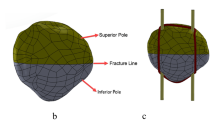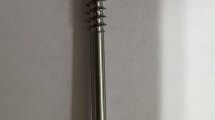Abstract
There are different stabilization methods used in surgical treatment of patellar fractures. The aim of this study was to determine the resistance against the distraction forces by three different and widely used fixation methods of the transverse fractures in calf patella. These fixation methods are as follows: (1) modified tension band (Group 1); (2) Malleolar screw (Group 2), and (3) tension band with Herbert screw (Group 3). Each experimental group had 10 calf patellas. Each patella was placed on a compression-tension testing system, and tension force was applied monotonically up to complete distraction at a loading rate of 15 Newton/second to the one site of the fractured patella. The force that corresponds to 2-mm distraction of the fracture site was accepted as the distraction force that causes the fixation failure. The mean values of the distraction forces were 350.5 ± 81.4 Newton (N) for Group 1; 977.90 ± 345.66 N for Group 2, and 957.30 ± 355.94 N for Group 3. Results established from each test group were statistically analyzed by using Mann–Whitney U-test. Group 1 was significantly different than Group 2 and Group 3. P values were 0.0013 and 0.0002, respectively. There was no significant difference between Groups 2 and 3 (P = 0.6232). As a result, we have concluded that malleolar screw (Group 2) and tension band with Herbert screw (Group 3) were the most stable fixation methods against distraction forces, and there was less resistance against the distraction forces in the modified tension band in Group 1.



Similar content being viewed by others
References
Grelsamer RP, McConnell J (1998) The patella. In: Grelsamer RP, McConnell J (eds) Normal anatomy. Aspen Publisher, Gaithersburg, pp 11–20
Finkemeier CG, Nerlich M (2007) Patella. In: Rüedi TP, Buckley RE, Moran CG (eds) AO principles of fracture management. AO Publisher, Stuttgart, pp 485–499
Lotke PA, Ecker ML (1981) Transverse fractures of the patella. Clin.Orthop 158:180–185
Bostrom A (1972) Fracture of the patella: a study of 422 patellar fractures. Acta Orthop Scand Suppl :143
Aglietti P, Buzzi R (1993) Fractures of the patella. In: Insall JN, Windsor RE, Scott WN, Kelly MA, Aglietti P (eds) Surgery of the knee. Churchill Livingstone, New York, pp 1085–1108
Levack B, Flannagan JP, Hobbs S (1985) Results of surgical treatment of patellar fractures. J Bone Joint Surg 67:416–419
Gardner MJ, Griffith MH, Lavvrence BD, Lorich DG (2005) Complete exposure of the articular surface for fixation of patellar fractures. J Orthop Trauma 19:118–123
Burvant JG, Thomas KA, Alexander R, Haris MB (1994) Evaluation of methods of internal fixation of transverse patella fractures: a biomechanical study. J Orthop Trauma 8:147–153
Carpenter JE, Kasman RA, Patel N, Lee ML, Goldstein SA (1997) Biomechanical evaluation of current patella fracture fixation techniques. J Orthop Trauma 11:351–356
Curtis MJ (1990) İnternal fixation for fractures of the patella, a comparison of two methods. J Bone Joint Surg 72:280–282
Benjamin J, Bried J, Dohm M, Mc Murtry M (1987) Biomechanical evaluation of various forms of fixation of transverse patellar fractures. J Orthop Trauma 1:219–222
Hughes SCA, Stott PM, Hearnden AJ, Ripley LG (2007) A new and effective tension-band braided polyester suture technique for transverse patellar fracture fixation. Injury, Int. J. Care Injured 38:212–222
Özdemir H, Özenci M, Dabak K, Aydın AT (2001) Patella Kırıklarında Cerrahi Tedavi Sonuçları. Ulusal Travma Dergisi 7:56–59
Carpenter JE, Kasman R, Matthews LS (1993) Fractures of the patella. J Bone Joint Surg 5:1550–1561
Sanders R, Gregory PR (1992) Patella fractures and extensor mechanism injuries. In: Browner BD, Levine AM, Trafton PG (eds) Skeletal trauma. Saunder Company, Philadelphia, pp 1685–1716
Gosal HS, Singh P, Field RE (2001) Clinical experience of patellar fracture fixation using metal wire or non-absorbable polyester: a study of 37 case. Injury 32:129–135
Berg EE (1997) Open reduction internal fixation of displaced transverse patella fractures with figure eight wiring through parallel cannulated compression screws. J Orthop Trauma 11:573–576
Szyszkowitz R (1991) Patella and tibia. In: Allgöwer M (ed) Manual of internal fixation: technique recommended by the AO-ASIF group. Springer, New York, pp 564–567
Weber MJ, Janecki CJ, Mc Leod P, Nelson CL, Thompson JA (1980) Efficacy of various forms of fixation of transverse fractures of the patella. J Bone Joint Surg 62:215–220
Hung LK, Chan KM, Chow YN, Leung PC (1985) Fractured patella: operative treatment using the tension band principle. Injury 16:343–347
Çekin T, Tükenmez M, Tezeren G (2006) Dana Modelinde Transvers Patella Kırıklarında Üç Farklı Tespit Yönteminin Karşılaştırılması. Acta Orthop Traumatol Turc 40:248–251
Dargel J, Gick S, Mader K, Koebke J, Penning D (2010) Biomechanical comparison of tension band and interfragmentary screw fixation with a new implant in transverse patella fractures. Injury, Int J Care Injured 41:156–160
Shabat S, Mann G, Kish B, Stern A, Sagiv P, Nyska M (2003) Functional results after patellar fractures in elderly patients. Arch Gerontol Geriatr 37:93–98
Makino A, Aponte LA, Muscolo L, Puigdevall M, Costa M (2002) Arthroscopic assisted surgical technique for treating patella fractures. Arthroscopy: J Arthroscopic Relat Surg 18:671–675
Tandoğan RN, Demirors H, Tuncay CI, Cesur N, Hersekli M (2002) Arthroscopik assisted percutaneous screw fixation of select patellar fractures. Arthroscopy: J Arthroscopic Rela Surg 18:156–162
Conflict of interest
None.
Author information
Authors and Affiliations
Corresponding author
Rights and permissions
About this article
Cite this article
Baydar, M.L., Atay, T., Gürbüz, Ö. et al. Compressive screwing of transverse patella fractures provides better resistance to traction than tension band. Eur J Orthop Surg Traumatol 21, 105–110 (2011). https://doi.org/10.1007/s00590-010-0672-y
Received:
Accepted:
Published:
Issue Date:
DOI: https://doi.org/10.1007/s00590-010-0672-y




